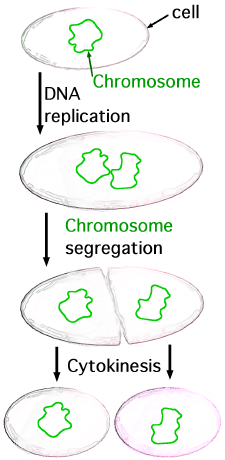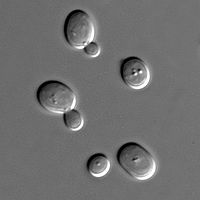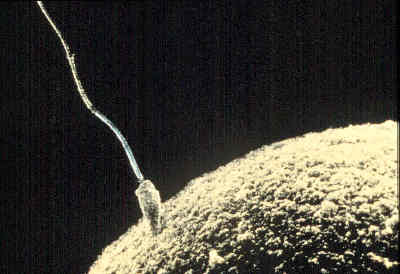What the Difference between Asexual and Sexual Reproduction?
What is asexual reproduction?
Asexual reproduction is reproduction without sex. In this form of reproduction, a single organism or cell makes a copy of itself. The genes of the original and its copy will be the same, except for rare mutations. They are clones. The main process of asexual reproduction is mitosis. This type of reproduction is common among some single-cell organisms, for example, amoeba. Many plants also reproduce asexually.
Types of Asexual Reproduction
Binary fissionA cell splitting and becoming two cells (overview)Some organisms like bacteria reproduce using binary fission. They split in two, so one bacterium becomes two bacteria. This always leads to daughter cells, and the offspring will be identical to the parent.
 |
Binary fission is a method of asexual reproduction. It is common in prokaryotes. A living cell divides into two cells. The two cells should be identical, but since mutation can occur, there might be slight differences. This process is basically when a prokaryotic organism divides into two parts. The parent cell divides to give rise to two daughter cells, the daughter cells then each develop into individual parent cells and give rise to two more daughter cells EACH, and so on and so forth. Image: Drawn by wiki:User:JWSchmidt |
Budding
 |
Budding is similar to binary fission, but it is used by plants and some animals, which cannot simply split in half as bacteria can. It is when a small part of a plant or animal breaks off and then, while they are separated from their "mother", they start to grow until both the "parent" and the "offspring" are the same size and both are capable of budding again. This may happen many more times. |
Spores
Fungi (for example, mushrooms) produce spores, which may be asexual or sexual. The asexual spores have the genetic material inside, which allows them to make a whole new organism identical to its parent.
What is sexual reproduction?
Sexual reproduction is a way of reproduction of some animals and plants. Some protists and fungi also reproduce this way. Organisms that reproduce sexually have two different sexes: male and female.
Offspring is made by a cell from the male and a cell of the female. Different steps are involved in the process.
The cells of an animal or higher plant have two sets of chromosomes: they are diploid. When gametes (sex cells) are produced, they have only one set of chromosomes: they are haploid. They have undergone a process of cell division called meiosis. During meiosis, crossing over occurs. This makes it possible to get recombination. This has various consequences. It means, for example, that all the children of two parents are not identical, except in the rare case where they developed from the same fertilized egg.
The second step is called fertilization. In it, the two cells merge into one. This restores the diploid state.
 |
Fertilization is what happens when a female's ovum (or "egg") joins together with a male's sperm and they form a zygote. Fertilization is also called conception. In humans, biologists call a fertilized egg a zygote. Image: wikipedia |
A zygote is the fertilized cell that will grow into a baby animal. When a female's ovum and a male's sperm cell become one, this cell is called the zygote. The zygote then multiplies, and grows into an embryo. A zygote is the cell that results from fertilization. A zygote is synthesized from the union of two gametes, and constitutes the first stage in a organism's development. Zygotes are produced by fertilization between two haploid cells, the ovum and the sperm cells, which make a diploid cell. Diploid cells have copies of parent chromosome or DNA.
Some animals keep the zygote in their bodies until it is a full-grown baby. The time between the forming of the zygote and the baby's birth is called pregnancy. Other animals do not keep the zygote in their bodies, but lay an egg. The zygote grows inside the egg until it is ready and the baby animal hatches. The fertilized egg now starts to divide and produce the embryo.
It is called an embryo from 3-8 weeks (the embryonic period.) Then after 8 weeks, it is called a fetus. If it continues to grow normally it can eventually become a baby.
Terms
Gonads- specialized sex organs where gametes are formed. In the male, the gonad is the testes, while in the female, the gonad is the ovaries.
Diploid cells- (indicated by 2n) have two homologous copies of each chromosome, usually one from the mother and one from the father.
Haploid cells -The haploid number (n) is the number of chromosomes in a gamete.
Gametes -- specialized sex cells formed in gonads by gametogenesis. The male gamete is the sperm, and the female is ovum(ova pl) or egg.
Zygote - produced by fertilization between two haploid cells, the ovum and the sperm cells, which make a diploid cell.
Advantages and Disadvantages
| Type | Advantage | Disadvantage |
| Asexual reproduction | No mate needed. Many offspring produced quickly | No variation in the offspring |
| Sexual reproduction | Genetic variation in the offspring. | Requires both sexes to participate. |
See also: Classification of Livings Things -- 5 Kingodoms or 6.
Related Sites
- Why is carbon monoxide so dangerous?
- The Hemoglobin S molecule and Sickle Cell Anemia
- What is the human genome and how big is it?
- How are living things classified?
- What are the components of blood?
- What is the path blood takes through the circulatory system?
- Where is food digested?
- Gifted and Talented STEM
- EDinformatics Science Challenge
What were the 100 Greatest Inventions?
See the list--Greatest Inventions of all Time
Gifted and Talented Activities
See: Math and Science Gifted and Talented
New-- Molecular Modeling For K-12 --A STEM Activity